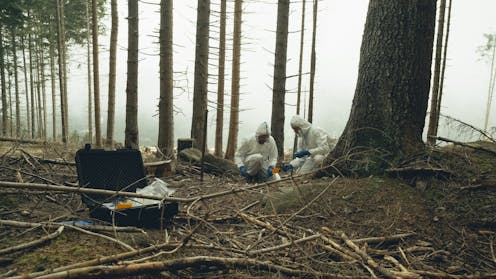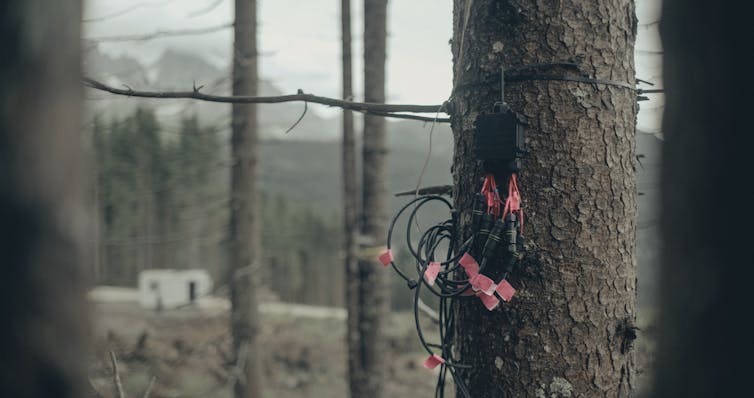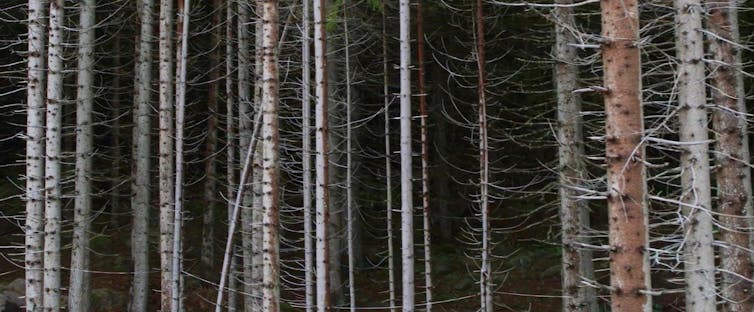Detta inlägg post publicerades ursprungligen på denna sida this site ;
Date:
Author: Monica Gagliano, Research Associate Professor in Evolutionary Biology, Southern Cross University
Original article: https://theconversation.com/a-living-collective-study-shows-trees-synchronise-electrical-signals-during-a-solar-eclipse-255499

Earth’s cycles of light and dark profoundly affect billions of organisms. Events such as solar eclipses are known to bring about marked shifts in animals, but do they have the same effect on plants?
During a solar eclipse in a forest in Italy’s Dolomites region, scientists seized the chance to explore that fascinating question.
The researchers were monitoring the bioelectrical impulses of spruce trees, when a solar eclipse passed over. They left their sensors running to record the trees’ response to the eclipse – and what they observed was astonishing.
The spruce trees not only responded to the solar eclipse – they actively anticipated it, by synchronising their bioelectrical signals hours in advance.
This forest-wide phenomenon, detailed today in the journal Royal Society Open Science, reveals a new layer of complexity in plant behaviour. It adds to emerging evidence that plants actively participate in their ecosystems.
Do trees respond collectively?
The research was led by Professor Alessandro Chiolerio of the Italian Institute of Technology, and Professor Monica Gagliano from Australia’s Southern Cross University, who is the lead author on this article. It also involved a team of international scientists.
A solar eclipse occurs when the Moon passes between the Sun and Earth, fully or partially blocking the Sun’s light.
An eclipse can inspire awe and even social cohesion in humans. Other animals have been shown to gather and synchronise their movements during such an event.
But scientists know very little about how plants respond to solar eclipses. Some research suggests the rapid transitions from darkness to light during an eclipse can change plant behaviour. But this research focuses on the responses of individual plants.
The latest study set out to discover if trees respond to a solar eclipse together, as a living collective.

Simone Cargnoni
What the research involved
Charged molecules travel through the cells of all living organisms, transmitting electrical signals as they go. Collectively, this electrical activity is known as the organism’s “electrome”.
The electrical activity is primarily driven by the movement of ions across cell membranes. It creates tiny currents that allow organisms, including humans, to coordinate their body and communicate.
The researchers wanted to investigated the electrical signals of spruce trees (Picea abies) during a partial solar eclipse on October 25, 2022. It took place in the Costa Bocche forest near Paneveggio in the Dolomites area, Italy.

Monica Gagliano
The scientists set out to understand the trees’ electrical activity during the hour-long eclipse. They used custom-built sensors and wired them to three trees. Two were healthy trees about 70 years old, one in full sun and one in full shade. The third was a healthy tree about 20 years old, in full shade.
They also attached the sensors to five tree stumps – the remnants old trees, originally part of a pristine forest, but which were devastated by a storm several years earlier.
For each tree and stump, the researchers used five pairs of electrodes, placed in both the inner and outer layers of the tree, including on exposed roots, branches and trunks. The electrodes were connected to the sensors.
This set-up allowed the scientists to monitor the bioelectrical activity from multiple trees and stumps across four sites during the solar eclipse. They examined both individual tree responses, and bioelectrical signals between trees.
In particular, the scientists measured changes in the trees’ “bioelectrical potentials”. This term refers to the differences in voltage across cell membranes.

Zenit Arti Audiovisive
What did they find?
The electrical activity of all three trees became significantly more synchronised around the eclipse – both before and during the one-hour event. These changes occur at a microscopic level, such as inside water and lymph molecules in the tree.
The two older trees in the study had a much more pronounced early response to the impending eclipse than the young tree. This suggests older trees may have developed mechanisms to anticipate and respond to such events, similar to their responses to seasonal changes.
Solar eclipses may seem rare from a human perspective, but they follow cycles which can occur well within the lifespan of long-lived trees. The scientists also detected bioelectrical waves travelling between the trees. This suggests older trees may transmit their ecological knowledge to younger trees.
Such a dynamic is consistent with studies showing long-distance signalling between plants can help them coordinate various physiological functions in response to environmental changes.

Zenith Audiovisual Arts
The researchers also detected changes in the bioelectrical responses of the stumps during the eclipse, albeit less pronounced than in the standing trees. This suggests the stumps were still alive.
The research team then used computer modelling, and advanced analytical methods including quantum field theory, to test the findings of the physical experiment.
The results reinforced the experimental results. That is, not only did the eclipse influence the bioelectrical responses of individual trees, the activity was correlated. This suggests a cohesive, organism-like reaction at the forest scale.

Zenit Arti Audiovisive
Understanding forest connections
These findings align with extensive prior research by others, highlighting the extent to which trees in forest ecosystems are connected.
These behaviours may ultimately influence the forest ecosystem’s resilience, biodiversity and overall function, by helping it cope with rapid and unpredictable changes.
The findings also underscore the importance of protecting older forests, which serve as pillars of ecosystem resilience – potentially preserving and transmitting invaluable ecological knowledge.
This research is featured in a documentary, Il Codice del Bosco (The Forest Code), premiering in Italy on May 1, 2025.

Zenith Audiovisual Arts
![]()
Monica Gagliano received funding for this research from the Templeton World Charity Foundation.
Prudence Gibson does not work for, consult, own shares in or receive funding from any company or organisation that would benefit from this article, and has disclosed no relevant affiliations beyond their academic appointment.

